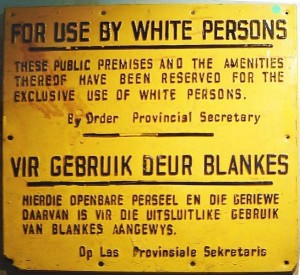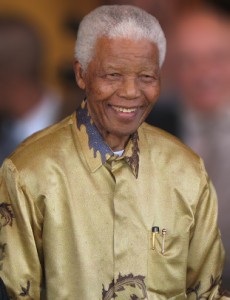Historical Background
South Africa is a land of abundant natural resources, mild climate, and fertile lands. Resources range from diamond and gold to platinum, and the land is fertile enough to feed the rest of the world if cultivated intensively. Yet many Europeans believed Africa to be the “Dark Continent,” a continent of poverty, harsh climate, and political turmoil (Woods 10). Though apartheid officially began in 1948, Africa’s history of racial domination and oppression began as early as the mid-17th century when the Dutch East India Company set up a provisioning station on the Cape (US Government Source).
White settlers from the Netherlands arrived in South Africa in the mid 17th century, forcing the occupants of South Africa out of their land or using them as laborers. The “Scramble for Africa” then came in the 18th and 19th century where the French, British, Portuguese, Germans, Belgians, Spanish, and Dutch colonized and took control of almost all the African continent (Woods 15). The country that would become South Africa was, at this time, fragmented into four major colonies.
By 1910, the four colonies were joined together under the Act of the Union, and the British handed the administration of the country over to the white locals. The Union preserved all regulations on black rights and also removed all parliamentary rights for Black people. In the three decades to follow until apartheid was established, racial segregation and white domination could be seen in all aspects such as land ownership, legal system, distribution of wealth and in the social relations.
Apartheid in Action
Apartheid, formally, was three hundred and seventeen laws by Dr. D.F. Malan’s nationalist party, which was elected in 1948. Apartheid added official and legal structure to the racial segregation and domination that already existed within the nation. Even before 1948,the Nationalist Party feared the influx of Africans into white towns, and therefore restricted the areas in which they could live. The whites passed various bills in the next four decades, to ensure that the movement of Africans into their towns were kept at a minimum, and to simultaneously reify political, economical, and social domination.
Bills Passed
- The Prohibition of Mixed Marriages Act, 1949, and Immorality Act, 1950, constituted the government’s first step in institutionalizing racial differentiation. These acts prohibited sexual intercourse and marriage between whites and Africans. All people over the age of sixteen were required to carry identity cards that grouped the people into various racial categories.
-

A sign from the Apartheid era/public domain The Groups Areas Act, 1950, restricted the entrance of Africans into the urban, industrial, and agricultural areas, reserving these areas only for the whites. Most people who were allowed to be within the reserved areas were workers, housemaids or gardeners, who were given state permission. Spouses and other family members were also restricted from living with those who were granted permission. If Africans were caught with family members who did not have the permission to be in the area, they were arrested and imprisoned, once spotted by the inspectors.
- The Population Registration Act, also in 1950, required that all residents of South Africa to be classified into three categories according to race. These were African, Colored, or White, and the government made these classifications according to a person’s habits, education, appearance, and manner. Rules were given according to race and had to be followed to prevent dire consequences.
- The Bantu Authorities Act, 1951, assigned all Black people to their native land, essentially stripping Blacks of power and influence. The Bantu Education Act applied apartheid to the educational system. The education of Whites, Africans, and Colored was separately administered and financed (see Colonial Education).
- The Abolition of Passes and Coordination of Documents Act, 1952, required all Africans to carry a pass-book, similar to a passport. The pass-book contained all personal information, such as name, photograph of holder, fingerprints, and also gave a detailed explanation on where a person could be employed, and their performance at work. If Africans did not obey the rules, they were kicked out from the area, and their crime would be reported in their pass-books. The penalty for not carrying the book at all times was also severe, ranging from imprisonment and fines, to a torturous death.
Education
Apartheid influenced the lives of all those residing in South Africa – including the children. Schooling was separated for all the races. Whites, Indians, Coloured, and Africans, attended different schools, except in some rare cases where Indian and African children were sent to the same school due to a lack of number in students. The white education was controlled by the Dept. of National Education, while the Indian, Coloured, and African education was governed by the Ministry of Internal Affairs. The per capita expenditure on education during 1980 to 1981 for whites were around 1000 rands, while for the Africans, it was 200 rands. Many schools for African children were constantly in need of repair, and classroom shortages were frequent. The student to teacher ratio for white schools was 1:18 and 1:48 for the African schools, in 1981. Due to the inadequate educational system of the African schools, many African students did not go beyond primary school, while the White children were mandated to attend school until the age of fifteen. By 1980, a survey showed that for an African school to create a curriculum more like the White schools, they would have to triple the expenditures for African schools.
Resistance to Apartheid

One of the first political organizations in Africa opposed to the apartheid was Lubumba Yama Afrika, which believed that the only way to fight the system of apartheid was through African unity. This party began in the 19th century, and spurred on many other parties from that point on. Opposition to apartheid was also influenced by outside powers, such as Mahatma Gandhi’s theory of non-violence. In 1960, a large group of Africans in Sharpeville revolted by not carrying around their pass-books. This resulted in the government declaring a state of emergency in this region. The emergency continued for 156 days, leaving 69 people dead and 190 wounded.
Many feared political protest, even if non-violent, because of the severe consequences which followed. Once arrested, many died in custody, or were sentenced to prison for life.
Nelson Mandela became involved with the ANC, African National Congress during the peak of the Second World War. Along with sixty other members, the mission of the ANC was to turn the group into a mass movement. By 1952, Mandela was elected National Volunteer-in-Chief. His job was to travel around the country, organizing resistance against discrimination. Because of his role in the ANC, Mandela was convicted of violating the Suppression of Communism Act and sent to a Johannesburg prison for six months. After the Sharpeville Massacre in 1960, the ANC was outlawed. Mandela continued to fight for the rights of his people, traveling illegally outside South Africa in 1962, and addressing the Conference of the Pan African Freedom Movement of East and Central Africa. After his return to Africa, he was once again arrested and sentenced to five years in prison. During these five years, he was charged with sabotage, and sentenced this time to life in prison. Like Gandhi, Mandela fought a war of non-violence and equal opportunities for all people. He was released on February 11th, 1990, and was elected as the first democratically chosen president of South Africa on may 10th 1994. In 1993, he received the Nobel Peace prize on behalf of all the South Africans who suffered to bring peace to the land. He died December 5, 2013.
The Outside World
Apartheid did not receive any international attention when the laws were first created in 1948. The rise of the civil rights movement in the United States and the revolt of colonial rule in Asia and Africa drew attention to the situation in South Africa (see African American Studies and Postcolonialism). The United Nations helped to draw more international attention by imposing an arms embargo in November 1977 and by creating a Security Council sanctions committee in December 1977. India helped to draw attention on the Indian population in Southern Africa and as various countries claimed their independence, the necessity for action to be taken on the apartheid increased. Internationally, other ways in which action was taken was by denying South African airways from landing in their countries, breaking off diplomatic relations with the government of South Africa, and boycotting all South African goods and refraining from exporting goods (Anti-Apartheid Movement 105). However, South Africa was indifferent to these international criticisms because of its continuance in economic prosperity.
The End of Apartheid
Apartheid finally came to an end in 1990 when president F.W. de Klerk announced a formal end to the apartheid. By 1991, all apartheid laws were repealed. The sanctions, created by the UN, were repealed as well. South Africa is presently in a process of transition. The government has been working to stimulate growth, create jobs, and to integrate the workforce. Foreign countries have been keen on integrating South Africa into their businesses. Though racism has not been erased from the lives of many people, South Africa is undergoing great changes even to this day. A recent New York Times article details how apartheid persists in South Africa in economic terms.
Works Cited
- “Apartheid, the Facts.” International Defense and Aid Fund for Southern Africa. London: A.G. Bishop and Sons Ltd., 1983.
- Coutsoukis, Photius. “South Africa.” (Oct. 1997) ABC Maps of South Africa. 20 Nov. 2000. Web. <http://www.theodora.com/wfb/south_africa/south_africa_maps.html>
- McCuen, Gary. The Apartheid Reader. Hudson: Gary McCuen Publications Inc., 1986.
- “Racism and Apartheid in Southern Africa.” Anti-Apartheid Movement. Paris: Unesco Press, 1974.
- Woods, Donald, and Mike Bostock. Apartheid: A Graphic Guide. New York: Henry Holt and Company, 1986.
- Woods, Donald. Apartheid: The Propaganda and the Reality. London: International Affairs Division, Commonwealth Secretariat, 1985.
Related Links
Author: Mai Noguchi, Fall 2000.
Last edited: October 2017
2 Comments
Hey there, You’ve done an incredible job. I will certainly
digg it and personally recommend to my friends.
I’m confident they’ll be benefited from this site.
South Africa has really suffered. In fact the whole of Africa has really suffered. Apartheid is the birth child of colonization and now from Apartheid we have xenophobia